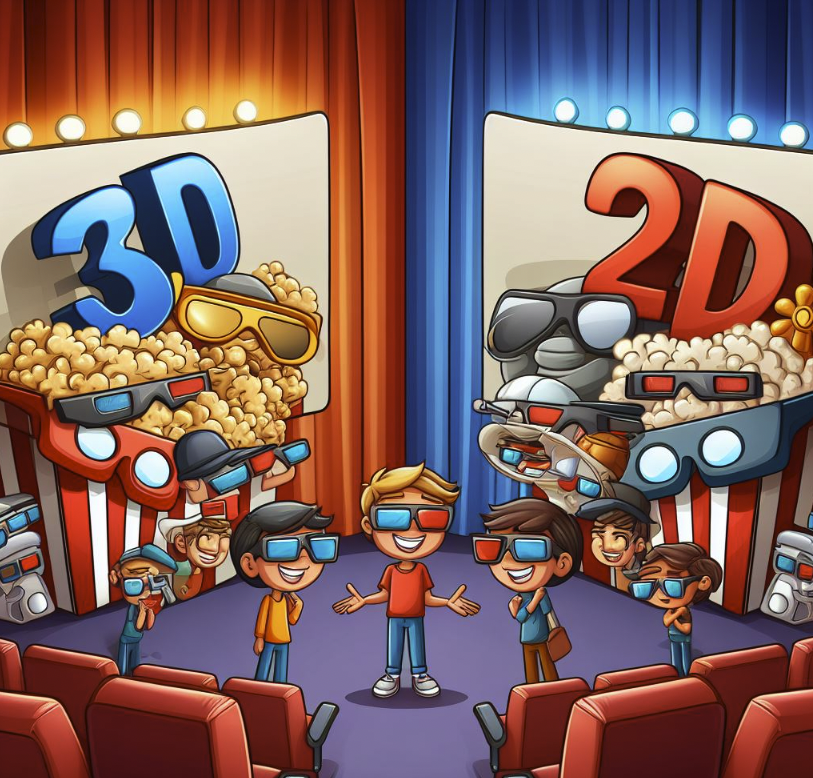The debate over whether 3D movies truly offer a better viewing experience compared to their traditional 2D counterparts remains a topic of contention among movie enthusiasts.
3D Movies vs. 2D Movies
3D Movies
- Visual Experience: Offers a depth perception and immersive visual experience.
- Glasses Required: Typically require special glasses to view.
- Ticket Price: Often more expensive than 2D movies due to the enhanced viewing experience.
- Visual Effects: Can provide stunning visual effects, making certain scenes more impactful.
- Limited Availability: Not all movies are available in 3D.
- Viewer Comfort: Some viewers may experience discomfort or headaches.
2D Movies
- Visual Experience: Standard viewing experience without depth perception.
- Glasses Required: No need for special glasses.
- Ticket Price: Generally less expensive than 3D movie tickets.
- Visual Effects: Visual effects are standard and lack the depth found in 3D movies.
- Wide Availability: All movies are available in 2D.
- Viewer Comfort: Typically more comfortable for a wider range of audiences.
3D movies can offer a unique and immersive viewing experience, particularly for certain genres and films with spectacular visual effects.
However, 2D movies are universally accessible, generally more comfortable to watch, and are available for all film releases.
The preference between the two can often come down to personal choice and the specific movie being viewed.
We will more deeply explore the various aspects of both 3D and 2D movies, examining their strengths and weaknesses to determine which format provides a superior cinematic experience.
Table of Contents
Visual Depth and Realism
One of the primary advantages of 3D movies is their ability to create a sense of depth and realism.
By utilizing stereoscopic technology, 3D movies can simulate the way our eyes perceive the world, resulting in a more immersive experience.
The added dimensionality allows viewers to feel as if they are part of the on-screen action, enhancing their overall engagement with the film.
On the other hand, 2D movies rely solely on the use of flat images projected onto a screen.
While this format has been the standard for decades, it lacks the visual depth that 3D movies offer.
As a result, some argue that 2D movies can feel less engaging and fail to provide the same level of immersion as their 3D counterparts.

Cinematic Techniques and Artistic Expression
When it comes to cinematic techniques and artistic expression, both 3D and 2D movies have their unique strengths.
3D movies often employ innovative camera angles and visual effects specifically designed to take advantage of the format’s immersive capabilities.
Directors can use depth to create visually stunning scenes and enhance storytelling.
On the other hand, 2D movies have a long history of artistic excellence.
Many iconic films, such as “Citizen Kane” and “Gone with the Wind,” were shot in 2D and continue to be celebrated for their cinematography and storytelling.
The absence of the third dimension allows filmmakers to focus on other aspects of filmmaking, such as composition, lighting, and framing.
Comfort and Accessibility
Comfort and accessibility are crucial factors to consider when comparing 3D and 2D movies.
While 3D movies offer a unique viewing experience, they are not without their drawbacks.
Some viewers may experience discomfort or even nausea when watching 3D movies due to the stereoscopic effect.
Additionally, wearing 3D glasses for an extended period can be cumbersome and may not be suitable for individuals with certain vision impairments.
On the other hand, 2D movies provide a more accessible and comfortable viewing experience for a wider range of audiences.
They do not require any additional equipment or specialized glasses, making them more inclusive for individuals with visual impairments or those who find 3D effects uncomfortable.
Film Selection and Availability
When it comes to film selection and availability, 2D movies have a clear advantage.
While the popularity of 3D movies has grown in recent years, the majority of films are still released in 2D format.
This means that moviegoers have a wider range of options when it comes to choosing a film to watch.
Furthermore, not all theaters are equipped with 3D projection systems, limiting the accessibility of 3D movies in certain areas.
This can be particularly challenging for individuals living in remote locations or regions with limited access to advanced cinema technology.
FAQs – 3D Movies vs. 2D Movies: Which Offers a Better Viewing Experience?
1. Are 3D movies more popular than 2D movies?
The popularity of 3D movies has grown in recent years, but the majority of films are still released in 2D format.
Therefore, 2D movies are generally more popular in terms of availability.
2. Do 3D movies provide a more immersive experience?
Yes, 3D movies can create a sense of depth and realism, making the viewing experience more immersive compared to 2D movies.
3. Can 3D movies cause discomfort?
Some viewers may experience discomfort or even nausea when watching 3D movies due to the stereoscopic effect.
It is important to consider personal comfort levels before choosing to watch a 3D movie.
4. Do 2D movies offer better artistic expression?
Both 3D and 2D movies have their unique strengths when it comes to artistic expression.
While 3D movies can utilize depth for visual effects, 2D movies often focus on other aspects of filmmaking, such as composition and framing.
5. Are 2D movies more accessible for individuals with visual impairments?
Yes, 2D movies are generally more accessible for individuals with visual impairments as they do not require specialized glasses or rely on the stereoscopic effect.
6. Are all theaters equipped to show 3D movies?
No, not all theaters are equipped with 3D projection systems. This can limit the accessibility of 3D movies in certain areas.
7. Can 3D movies be enjoyed without wearing glasses?
No, 3D movies require the use of specialized glasses to achieve the stereoscopic effect. Without the glasses, the 3D effect will not be visible.
8. Do 2D movies lack visual depth?
Compared to 3D movies, 2D movies lack the added dimensionality that creates visual depth.
However, this does not necessarily mean that 2D movies lack visual appeal or quality.
9. Are there any advantages to watching 2D movies?
Yes, 2D movies provide a more comfortable and accessible viewing experience for a wider range of audiences. They also offer a wider selection of films compared to 3D movies.
10. Can 3D movies enhance storytelling?
Yes, 3D movies can utilize depth and visual effects to enhance storytelling and create visually stunning scenes.
However, storytelling can be equally compelling in 2D movies through other cinematic techniques.
11. Are 3D movies more expensive than 2D movies?
Yes, 3D movies are often priced higher than their 2D counterparts due to the additional production costs associated with creating and projecting 3D content.
12. Do 3D movies require special equipment at home?
Yes, to watch 3D movies at home, viewers need a 3D-enabled television or projector and compatible glasses.
This can add to the overall cost and complexity of enjoying 3D content.
13. Can 2D movies be converted into 3D?
Yes, it is possible to convert 2D movies into 3D using post-production techniques.
However, the quality of the conversion may vary, and it may not provide the same level of immersion as movies originally shot in 3D.
14. Are there any health risks associated with watching 3D movies?
For most individuals, watching 3D movies poses no significant health risks.
However, some people may experience discomfort or nausea due to the stereoscopic effect. It is important to take breaks if any discomfort arises.
15. Can 2D movies be as visually stunning as 3D movies?
While 3D movies offer a unique visual experience, 2D movies can be equally visually stunning through the use of composition, lighting, and other artistic techniques.
Summary – 3D Movies vs. 2D Movies: Which Offers a Better Viewing Experience?
After considering the various aspects of both 3D and 2D movies, it is clear that each format has its own strengths and weaknesses.
While 3D movies offer a more immersive and visually stunning experience, they may not be suitable for all viewers due to potential discomfort and limited accessibility.
On the other hand, 2D movies provide a more accessible and comfortable viewing experience, with a wider selection of films available.
Ultimately, the choice between 3D and 2D movies depends on personal preferences and the specific film being watched.
Some movies are specifically designed to take advantage of the immersive nature of 3D, while others may be better suited for a traditional 2D format.
Regardless of the format chosen, what truly matters is the quality of the storytelling and the ability of the film to captivate and engage its audience.


